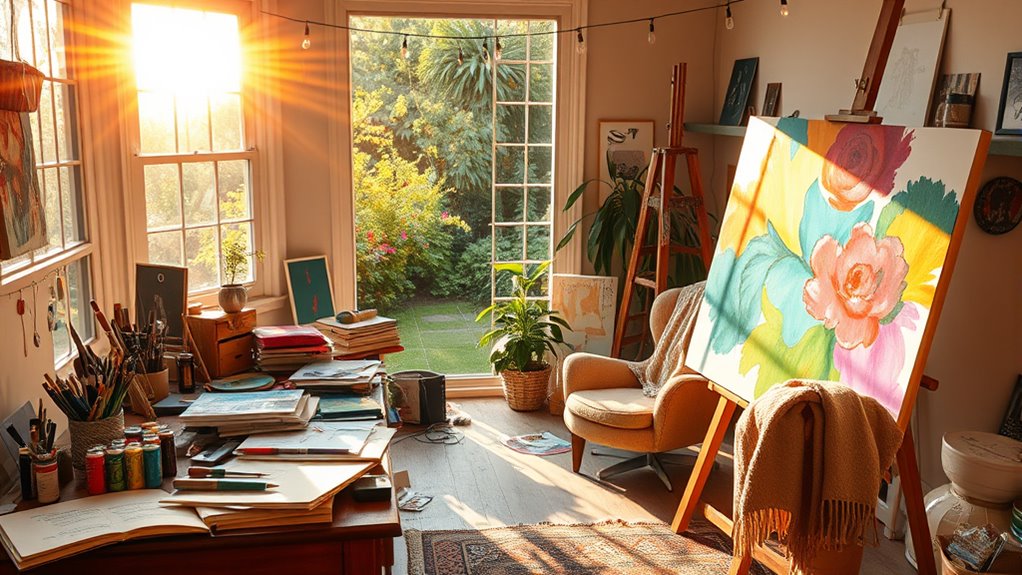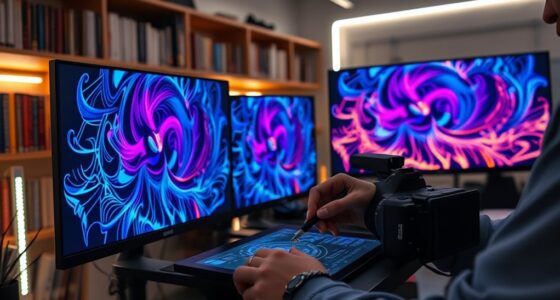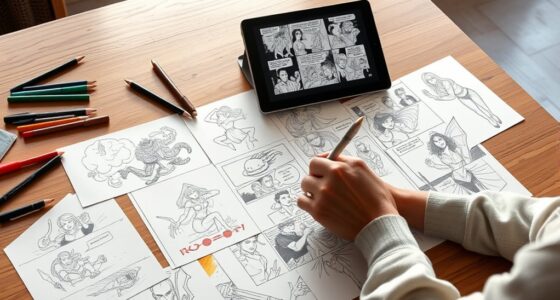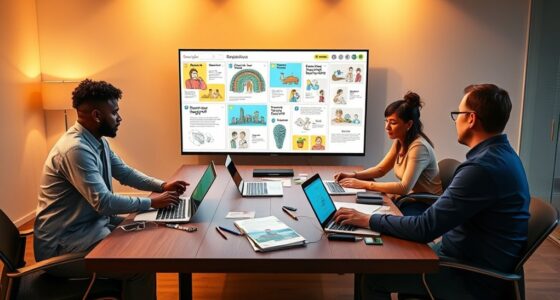When facing creative blocks, try simple mindfulness exercises like focused breathing or body scans to clear your mind and reduce stress. Changing your environment—like moving outdoors or rearranging your workspace—can also spark fresh ideas. Combining these approaches helps you reconnect with your creativity by breaking mental patterns and clearing clutter. Small acts such as walking or tidying up can make a big difference. To explore more effective strategies, keep going—you’re closer than you think to reigniting your inspiration.
Key Takeaways
- Practice mindfulness exercises like focused breathing or body scans to clear mental clutter and promote creative flow.
- Change your environment by moving to new locations or rearranging your workspace to stimulate fresh ideas.
- Combine mindfulness with environmental shifts to create a mental space conducive to inspiration and overcome stagnation.
- Engage in different art forms or communities to introduce new perspectives and reignite your creative energy.
- Take small routine breaks, such as walks or tidying, to signal permission to reset and facilitate breakthroughs.

Creative blocks can feel like insurmountable barriers, but they’re often a sign that your mind needs a reset or a fresh perspective. When your creativity stalls, it’s easy to get caught in a cycle of frustration, but instead of pushing harder, try stepping back and giving yourself space to breathe. One effective way to do this is through mindfulness exercises. These practices help you become more aware of your thoughts and emotions, reducing stress and clearing mental clutter. Even just a few minutes of focused breathing or body scans can ground you in the present moment, easing anxiety and opening space for new ideas to emerge. Incorporating mindfulness into your routine isn’t about forcing inspiration but about creating a mental environment where creativity can flow naturally again.
Alongside mindfulness, a simple yet powerful strategy is a change of environment. Sometimes, your usual workspace or creative setting becomes a mental trap, reinforcing stagnation. Moving to a different location—whether it’s stepping outside into nature, working in a different room, or even rearranging your current space—can stimulate your senses and spark new ideas. Changing your environment shifts your perspective and disrupts habitual thought patterns that might be contributing to your creative block. It’s like giving your brain a fresh canvas to work on, free from the mental associations tied to your usual surroundings. When you combine this with mindfulness exercises, you create a dual approach that addresses both mental clutter and environmental stagnation, making it easier to reconnect with your creative energy.
Another helpful approach is to explore resources and tools such as engaging with different art forms, online inspiration boards, or creative communities, which can provide new stimuli and encouragement. You don’t need elaborate setups or drastic changes to reap the benefits. Sometimes, simply taking a walk in a nearby park, sitting by a window, or tidying your workspace can make a significant difference. The key is to be intentional about breaking your routine and giving yourself permission to step away from the pressure of producing. These small acts signal to your mind that it’s okay to pause and reset, which often leads to a surge of inspiration once you return to your work. Remember, creative blocks are not permanent obstacles but signals that your mind needs a gentle nudge in a new direction. Using mindfulness exercises and a change of environment can help you navigate through these moments with patience and clarity, ultimately restoring your creative flow.
Frequently Asked Questions
How Long Do Creative Blocks Typically Last?
Creative blocks vary in duration depending on the person and situation, with some lasting days and others weeks or more. You can expect some variability, but building emotional resilience helps you bounce back faster. During longer blocks, try changing your environment or seeking inspiration. Remember, patience is key—understanding that the duration variability is normal allows you to stay motivated and confident in your creative journey.
Can Physical Health Affect Creative Blockages?
Yes, physical health markedly impacts your creative blocks. When your physical wellness is compromised, it affects brain health, which can make it harder to focus, think creatively, or generate new ideas. Poor sleep, nutrition, or stress levels hinder cognitive functions, leading to increased creative blocks. Prioritizing your physical health by exercising, eating well, and managing stress can boost brain health and help you break through those creative barriers more easily.
Are There Specific Signs That Indicate a Creative Burnout?
You might notice signs of creative burnout through stress signs like constant frustration or feeling overwhelmed, and fatigue indicators such as persistent tiredness or lack of motivation. When your enthusiasm wanes, and you struggle to generate ideas despite effort, it’s a clear signal. If these signs persist, it’s time to pause, recharge, and restore your mental energy to reignite your creative spark.
How Do I Measure Progress in Overcoming a Creative Block?
You can measure progress in overcoming a creative block by tracking milestones, like completing a project phase or generating new ideas. Reflecting on your progress helps you see how your confidence is rebuilding and your inspiration is returning. Celebrate small wins, notice increased ease in your creative process, and compare your current work with earlier efforts. These signs indicate you’re moving forward and your creative flow is gradually restoring.
What Role Does Collaboration Play in Breaking Creative Blocks?
Collaboration plays a pivotal role in breaking creative blocks by sparking new ideas through group brainstorming. When you work with others, you gain fresh perspectives that challenge your usual thinking patterns. Peer feedback helps you refine your concepts and see potential solutions you might overlook alone. By engaging with a team, you create a dynamic environment that fosters inspiration, motivates you to push through obstacles, and accelerates your creative process.
Conclusion
Now that you’ve got these strategies, nothing can hold back your creativity. Remember, even da Vinci faced blocks and found ways to push through. When inspiration stalls, take a step back, breathe, and try something unexpected—like scribbling on a napkin in a bustling café. With patience and persistence, you’ll turn those blank pages into masterpieces, just like the greats did in their time. Keep creating, and let your passion be your guiding compass.









